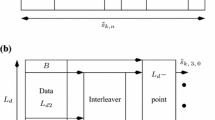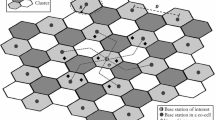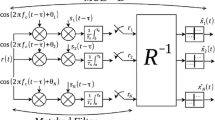Abstract
A direct-sequences code division multiple access system has been accepted as a digital cellular standard (IS–95) in North America [1]. This digital cellular standard employs a powerful rate 1/2, constraint length 9, convolutional code in its forward link. It is well-known that in a Rayleigh fading channel the performance of a channel code depends very heavily on the interleaving depth and the relative variations of the channel characteristics. In slow fading channels, since the input symbols to the channel decoder are highly correlated, the bit-error-rate at the output of the channel decoder may be unacceptably high. Interleavers of large dimensions can reduce the correlation of the input signal to the channel decoder at the expense of an intolerable delay. In this paper we examine the performance of the IS–95 system, at the mobile receiver, for different channel fade rates. Also, we present a simple time diversity technique which employs multiple receive antennas. The multiple receive antennas in this case generate a fast fading effect and thus improves the performance of the channel decoder significantly.
Similar content being viewed by others
References
TIA/EIA/IS–95, “Mobile Station-Base Station Compatibility Standard for Dual-Mode Wideband Spread Spectrum Cellular System”, Telecommunication Industry Association, July 1993.
R. Padovani, “Reverse Link Performance of IS–95 Based Cellular Systems”, IEEE Personnel Communications, Vol. 1, No.3, pp. 28–34. Third Quarter, 1994.
K.S. Gilhousen, I.M. Jacobs, R. Padovani, A.J. Viterbi, L.A. Weaver and C.E. Wheatley, “On the Capacity of a Cellular CDMA System”, IEEE Trans. on Veh. Technol., Vol. 40, No.2, pp. 303–312, 1991.
H. Iwai, M. Yasunaga, and Y. Karasawa, “A Fading Reduction Technique Using Interleave-Aided Open Loop Space Diversity for Digital Maritime-Satellite Communications”, IEICE Trans., Vol. E 74, No.10, pp. 3286–3294, 1991.
V. Weerackody, “Characteristics of a Simulated Fast Fading Indoor Radio Channel”, Proc. 43rd IEEE Veh. Technol. Conf., pp. 231–235, 1993.
A. Hiroike, F. Adachi, and N. Nakajima, “Combined Effects of Phase Sweeping Transmitter Diversity and Channel Coding”, IEEE Trans. Veh. Technol., Vol. 41, pp. 170–176, 1992.
A.J. Viterbi, A.M. Viterbi, and E. Zehavi, “Other-Cell Interference in Cellular Power-Controlled CDMA”, IEEE Trans. on Commun., Vol. 42, No.4, pp. 1501–1504, 1994.
M. Kavehrad and B. Ramamurthi, “Direct-Sequence Spread Spectrum with DPSK Modulation and Diversity for Indoor Wireless Communications”, IEEE Trans. Commun., Vol. 35, pp. 224–236, 1987.
J.S. Lehnert and M.B. Pursley, “Multipath Diversity Reception of Spread-Spectrum Multiple-Access Communications”, IEEE Trans. Commun., Vol. 35, No.11, pp. 1189–1198, 1987.
C.E. Wheatley, R. Padovani and E. Zehavi, “Fast Forward Link Power Control in a Code Division Multiple Access System”, U. S. Patent No. 5 383 219, Jan 17, 1995.
G.L. Turin, “Introduction to Spread-Spectrum Anti-Multipath Techniques and Their Application to Urban Digital Radio”, Proc. IEEE, pp. 328–353, 1980.
M.J. Gans, “A Power Spectral Theory of Propagation in the Mobile Radio Environment”, IEEE Trans. Veh. Technol., Vol. VT-21, pp. 27–38, 1972.
J.G. Proakis, Digital Communications, McGrawHill, Second Edition, 1989.
Author information
Authors and Affiliations
Rights and permissions
About this article
Cite this article
Weerackody, V. Effect of Time Diversity on the Forward Link of the DS-CDMA Cellular System. Wireless Personal Communications 7, 89–109 (1998). https://doi.org/10.1023/A:1008818020430
Issue Date:
DOI: https://doi.org/10.1023/A:1008818020430




